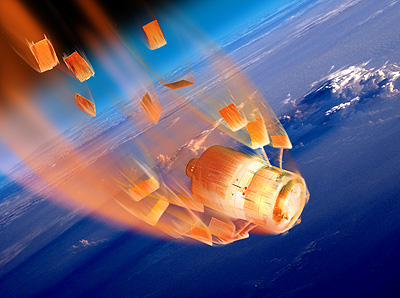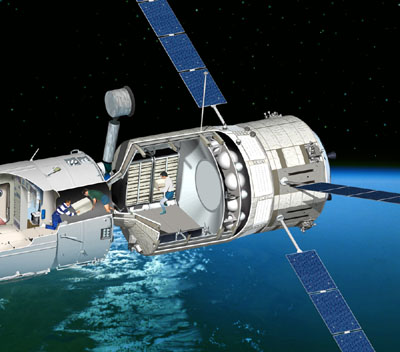A new European supply spacecraft will launch in early 2008
Amber dew. Published in Galileo, issue 108, August 2007

This unique supply spacecraft is expected to fly into space aboard the heavy European Ariane 5 launcher (rocket), which will take off from the European Space Base in Kourou, French Guiana in South America. This spaceship, the construction of which was recently completed at the facilities of the European Space Corporation EADS, is the product of about ten years of work and huge investments.
Besides its future use as a "space truck", the latest European spacecraft excels in the most advanced technologies, which allow it to navigate independently in space, locate the rendezvous destination and perform the maneuvers required to approach and dock with the International Space Station. The first spaceship was sent on its way by an ancient means of earthly transportation - a ship. After sailing for about a week, the ship will anchor in the port of Koro. The process of preparing for the launch is expected to last about 18 weeks from the moment it arrives at the facility. The planned launch date of the Jules Verne spacecraft is January 2008 (this date may change - there is already a significant delay in the project's schedule).
According to the plan, the spacecraft will deliver to the International Space Station 7,500 kg of supplies (food, water, clothing, scientific equipment, fuel for the station's maneuvering engines, spare parts, etc.), and the current plan of the partners in the station is to launch one spacecraft of this type per year. At this point, the European Space Agency intends to build at least 7 spacecraft of this type.
Jules Verne - technical data
- Length: 10.3 meters
- Diameter: 4.5 meters
- Mass at launch: 20 tons
- Cargo carrying capacity to the space station (from the total mass at launch): 7.5 tons
- Ability to stay in space: 6 months
- Compressed volume: 48 cubic meters
- Number of maneuvering engines: 32
The spacecraft's large amount of fuel allows it to assist in various maneuvers that the International Space Station is required to perform from time to time - especially to raise its orbit. The International Space Station circles the Earth at an altitude of about 400 km, where there are still faint remnants of an atmosphere. In its fast movement (almost 8 kilometers per second), the station hits the few air molecules, and over time drag is created, causing the space station to slow down. If this problem is not addressed, the speed of the station will decrease to such an extent that it will not remain in orbit around the Earth. In order to prevent this situation, the International Space Station is equipped with a series of maneuvering engines, which are automatically activated by the station's computers. Of course, it is necessary to add fuel to these engines from time to time, and this is one of the missions of the new European spacecraft. Additional maneuvers that the International Space Station performs when necessary are designed to avoid space debris.
When Jules Verne connects to the space station, all the maneuvers required for the station will be able to be performed with the help of this spacecraft, and the load on the station's other maneuvering systems will decrease. The Jules Verne spacecraft will receive the necessary data to perform orbit corrections from the station's computer. Although it has appropriate gauges (sensing means), at this stage it is not intended to rely on its ability to sense the position of the entire space station and rely on this sensing to perform the maneuvers. At the same time, this ability can be a backup in the event of a malfunction in the space station's systems.
Autonomy in space
One of the biggest challenges faced by the designers of the Jules Verne spacecraft is related to the control and control systems that were installed in it. From the beginning, the engineers aimed to build a largely autonomous spacecraft, that is, a spacecraft that would know how to find Nativa in space to its destination, and would be able to measure its distance to the space station and perform the necessary operations for docking without human intervention. In this field, of automatic supply spacecraft, the Russians were pioneers, back in the seventies of the 20th century. But unlike the Russian spacecraft (which are in use to this day), the Jules Verne spacecraft is equipped with laser systems for range measurements, which allow unprecedented precision in rendezvous and docking maneuvers in space.
Guiding the spacecraft to the International Space Station will use a variety of navigation techniques, including the GPS satellite navigation system (and in the future, upon its completion, also the European Galileo navigation system), a radar rangefinder and a series of laser-based rangefinders. The last maneuvers towards the independent docking to the International Space Station will be assisted by laser systems for measuring small distances - down to fractions of a millimeter!
Compressed unit

The engineers of the European Space Agency took care of a flexible modular design - the spacecraft can be designed according to demand in a relatively short time. Thus, for example, if a new laboratory assembly is required in a certain field, it can be launched into space within a few months, as opposed to the usual period of time for developing a standard assembly for the space station - many years. A Jules Verne spacecraft is capable of functioning as a temporary assembly of the International Space Station for periods of up to six months.
How do you "remove the garbage" in space?
After the Jules Verne spacecraft is emptied of the supplies it will bring to the International Space Station, it has another use left, and that is waste disposal. The accumulated waste in the space station (leftover food, dirty clothes, broken and unnecessary equipment and even waste from the space station sewers) cannot be simply thrown out of the spacecraft, so that it does not become space debris that would endanger satellites in orbit. Therefore it must be cleared, and Jules Verne is also suitable for this purpose. After each volume is filled with trash, it will be released from its docking station on the space station and begin a series of motorized maneuvers aimed at causing the spacecraft to lose altitude and enter the Earth's atmosphere in such a way that it will burn up completely. To be safe, the atmospheric entry maneuver will be performed over the Pacific Ocean, in case some fragments reach the ground.
It should be noted that the Soviets were the first to use a cargo spaceship to dispose of waste from space, and they did so using the Progress supply spaceships. The International Space Station also uses Progress spacecraft for garbage disposal, but the volume of the spacecraft available for storing waste is much smaller than that of Jules Verne-type spacecraft. Inside a spacecraft of this type, up to 6,500 kg of waste can be stored - a very large amount compared to the means available today (which rely on the Progress spacecraft and the American space shuttle). We note that a lot of waste accumulates on the International Space Station, causing great discomfort to the astronaut team - the waste is stored in work and living units, significantly reducing the crew's living space.
Compatibility with additional launchers
In lectures given as part of the 2006 World Space Congress, held in Valencia, Spain, speakers from the Japanese Space Agency presented feasibility studies for launching the Japanese supply spacecraft, which is largely similar to the European Jules Verne spacecraft. The Japanese plan to launch their cargo spacecraft into space on the Japanese H II A launcher, but various adjustment works will also allow the routine to space on the European Ariane 5 launcher and the American Delta 4 launcher.
At this stage, there is no information about a similar intention of Europe to adapt the Jules Verne spacecraft to launch using other launchers besides Ariane 5. It should be emphasized, at the same time, that the weight and size data allow the launch of the European spacecraft on both the Japanese and the American launcher, with simple adjustments and tests and relative speed. It will be interesting to follow the developments on the subject, and see if the EADS Corporation and the European Space Agency will follow the path of the Japanese Space Agency, and will enjoy operational flexibility in launching the spacecraft with several launcher models.
Spacecraft launcher: Ariane 5
The Jules Verne spacecraft will, as mentioned, be launched into space in the nose of the heavy European launcher Ariane 5, in its sub-model developed and adapted for it. The Ariane 5 launcher was developed for more than a decade, and is intended to replace the European Ariane 4 launcher and be a leap forward in terms of launched weight, reliability and simplicity. The launcher was developed by European companies, mainly companies from France, led by Aerospeciale.
The maiden launch of the Ariane 5 launcher was held in February 1996, and ended in failure, due to a bug in the launcher's guidance software. However, over the years, the launcher has become the "workhorse" of the space world, and it launches many communication satellites into geosynchronous orbit. It should be noted that so far this launcher has not been used to launch a Ted into a low orbit, which is required for the Jules Verne spacecraft. For its missions, a special model of Ariane 5, known as "Ariane 5 ATV ES", was adapted and developed.
The Ariane 5 launcher consists of three main parts:
- The first stage: powered by liquid fuel (liquid hydrogen and liquid oxygen)
- Two rocket boosters, powered by solid fuel
- Second stage, powered by liquid fuel (liquid hydrogen and liquid oxygen)
The development of the model for launching into a low orbit can open diverse possibilities for launching research satellites, spacecrafts to other planets and more. An Ariane 5 launcher of this type will also be able to launch components to a future European space station (for the era after the end of the operation of the International Space Station - the official date for the end of the project is 2030, but key officials in various space agencies indicate that the United States is considering withdrawing from the station in 2014-2016), Or even for manned space missions to the moon, which are also hinted at in the corridors of the European Space Agency, for the years 2020-2025.
Sources and additional information

6 תגובות
And what they do is simply connect many units together and there is no principle here, it's just units that are connected to each other
Until they put everything together and no longer need the space station
Right
Nice, relatively small cargo for the Russian spaceships (Suiz),
The problem with the International Space Station, when they finally finish building it (2010?) it will already be about 13 years old, which is very old. You have to build something on the ground within 4 years at the most and then raise it within a year or so because it's not efficient...